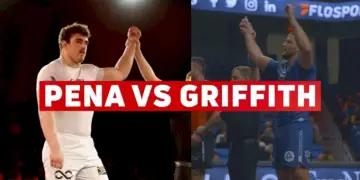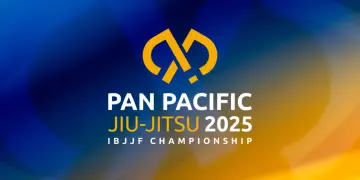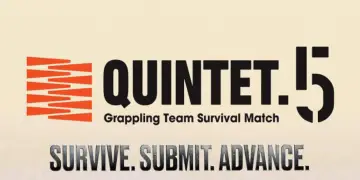This article is part of our Craig Jones Invitational 2024 coverage. To get live results, play by play, and commentary, we’ll have a live updates article running all weekend.
Brandon McCaghren just gave a first look at the official Craig Jones Invitational rules and there’s a few great bits of information for anyone looking forward to the event. There’s been a lot of hype surrounding the tournament thanks to Craig Jones’ marketing strategy and the fact that it’s going up against ADCC 2024 head on. Despite all the attention around CJI, not much information has actually been released about the rules in use. Jones announced that it would be taking place in a structure similar to the Karate Combat pit and that rounds would be used in each match, but that has been it so far.
Craig Jones Invitational Rules
McCaghren managed to get a hold of the official rules and the first thing he clarified is how the rounds and scoring for each match will work:
“We’re going to be working with three five-minute rounds with one minute of rest in between each round. So right away the ruleset is totally different from anything else out there. I say anything else, AIGA had some similarities… I loved AIGA but their scoring inside of it was vastly different than this one here, like they actually score points inside the rounds. There’s not gonna be any points scored in this one, we’re going to be working with a 10-point must system just like MMA.”
Brandon McCaghren is right, the Craig Jones Invitational is not the first promotion to make use of rounds in their rules. The Abu Dhabi Extreme Championship did it too, but they also used a more traditional point-scoring format as well. McCaghren went on to explain exactly how their scoring system will work:
“Rounds will be judged individually on a 10-point must system. Under the 10-point must scoring system, 10 points are awarded to the winer of the round and 9 points or less must be awarded to the loser. A submission always leads to an immediate win of the entire match, obviously. In all matches except for the final match of each division, if both athletes end up with the same score, for example 28-28, the athlete who won the third round will be determined the winner.”
The finals are going to have a slightly different approach in the event of a draw though:
“The finals of each bracket: five five-minute rounds with a little caveat right here, plus five minutes of overtime if the points are drawn after round five. So they’re going to keep going.”
Craig Jones Invitational Scoring Criteria
One of the most interesting thing about the scoring system for the Craig Jones Invitational isn’t actually the format though, it’s the criteria they’re using within that format. According to McCaghren, this is the exact order of what they’re looking for and how the judges will be deciding who wins each round:
- “Number 1, initiating action. That is the number 1 criteria that they’re going to be looking for, who’s pushing the action and who’s pushing forward. The highest reward is for initiating action; attempting takedowns, guard passes, sweeps, submissions etc. Judges will give the highest reward to the competitor who is aggressive, the one starting the action and attacking that leads to the scramble.”
- “Number 2, close submissions and dynamic action. Dynamic action is defined as takedowns, sweeps, passes etc. After initiating action, progressing through control and position to submission attempts weighs heavy on the judges. So this is the second most important criteria.”
- “Number 3, very important, positional control and dominant control. This is the last factor. If all else is equal, the competitor who controlled the match positionally or dictated the pace of the match will be rewarded.”
This is a huge difference to the majority of BJJ rulesets, as they generally favor those dynamic actions first before looking at positional control and finally considering who initiated the action. By focusing on aggression first and foremost, the logical outcome here is that competitors are incentivised to push the action from start to finish. This should lead to more exciting matches and it’s clear that the Craig Jones Invitational have created their rules with action in mind right from the start. They’re also taking action against stalling too:
“Referee, following a warning notification, can enforce a stalling penalty. In their sole discretion a referee may apply a negative point or apply a negative point and reset the position.”
Craig Jones Invitational Legal Techniques
One of the most important things to note for any ruleset is obviously the actual techniques that are allowed during the match. The rules for the Craig Jones Invitational are hardly going to limit competitors at all though:
“All chokes are legal except for using the hand to close the windpipe, obviously. Armbar, shoulder-lock, wristlock, leglock, any ankle-lock all allowed. Can opener allowed, Twister allowed and this is a difference in the ADCC ruleset; full nelson is allowed. In ADCC you’re not allowed to crank the neck with both shoulders behind the head which interesting, I don’t really understand that… Pretty much any submission hold that you can think of is legal, fair game at the Craig Jones Invitational.”
Another key element of the ADCC ruleset is that competitors are allowed to slam their way out of submissions and fortunately for any grapplers moving away from that tournament, that isn’t changing at CJI:
“Slamming is allowed if you’re locked in a submission. If your opponent lets go of the submission before the slam then you got to let go and abort the slam. About the same as ADCC. No spiking, all the usual stuff…”
Brandon McCaghren uploaded the video where he takes a look at the rules for the Craig Jones Invitational to his official YouTube channel:












